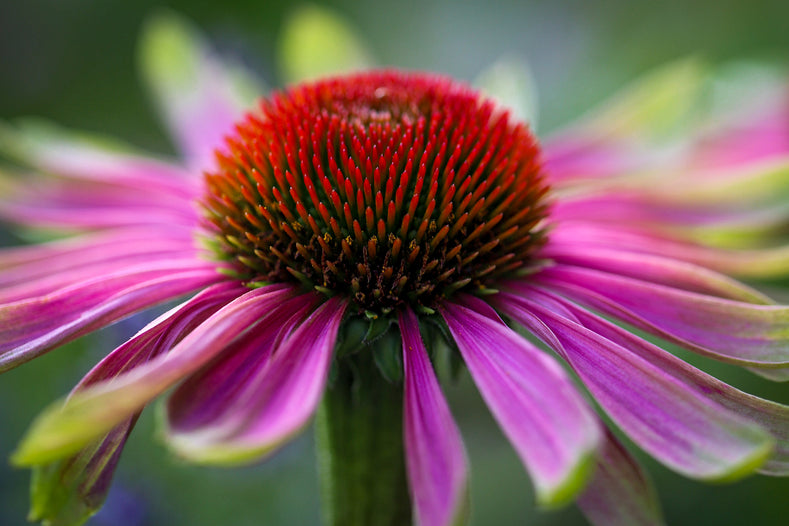The Coneflower ‘Green Twister’ is a flamboyant flower that demands attention! Its sweet scent and spectacular colors are irresistible to bees, butterflies, and songbirds, whilst its low-maintenance, high-impact personality will delight gardeners season after season.
All About the Green Twister
The Green Twister is a member of the Echinacea purpurea species of flowering perennials that are most commonly known as coneflowers. The genus name Echinacea is taken from the Ancient Greek word ekhinos, which translates loosely to ‘prickly’ or ‘hedgehog’, an homage to the spiky central pistils displayed by all coneflowers.
Coneflowers are ancient wildflowers, native to the meadows and prairies of North America, but Green Twister is a relatively recent, exciting discovery. It was discovered accidentally by a flower breeder working in Germany. He initially thought its ostentatious coloring was the result of a virus, when in fact, the clashing colors are naturally occurring!
Luckily, Green Twisters are now renowned and adored for their curious color combinations. Their fuchsia petals fringed with lime green borders encircle spiky, spherical seed pods of fiery scarlet hues. Although they may seem like one large flower, each flowerhead is actually made up of hundreds of tiny florets. Flowering from mid to late summer, and sometimes with a second bloom in fall, these quirky plants are perfect for informal cottage, prairie, or wildflower gardens.
Whilst Green Twister is mainly cultivated as an ornamental, its species Echinacea purpurea is renowned for its healing powers! For centuries, Native Americans have used Echinacea to treat a huge array of ailments, from burns to toothaches to snake bites. In modern herbal medicine, Echinacea is often used to alleviate symptoms of the common cold, or brewed into invigorating, immune system-boosting teas.

Growing Green Twisters
Getting started
Twister bulbs can be started in the fall when the air is cool but the days are still bright, or in spring once the last frost has passed. Your Twisters will arrive as “bare root plants” with a few spaghetti-like roots protruding from the bulb. Dunk them into a bucket of water for a good soak (three to six hours should do it), until plump. Start your Twisters off in individual well-draining pots filled with rich compost, pointing them tendril end down. Place them in a sheltered position in your garden and water them regularly but lightly until late spring, when they will be well established and ready to plant out.
Twisters have a maximum spread of around 25 inches, and they don't like being overcrowded, so allow plenty of room for them to spread out as they grow. If you’re growing them in containers, choose a wide, deep pot that will give established roots lots of room to spread, and make sure there’s plenty of drainage holes. Bury the young Twisters just deep enough to avoid bending the bulb tendrils and give them a good soaking.
Soil
Twisters tolerate most soil types, so long as it’s well-draining. Work plenty of nutrient-rich, organic matter through the soil before planting. This helps to feed your Twisters and improve drainage.
Light
True sun-worshippers, Twisters bloom most abundantly with six to eight hours of full sun each day, although they’ll do just fine in dappled shade. Avoid deep shade though, as their stems may become floppy.
Water
Throughout spring and summer, aim to give established Twisters around an inch of water per fortnight to keep the soil lightly moist. They are fairly drought tolerant though, so forgetful gardeners needn’t worry too much!
Fertilizer
Less is more when it comes to feeding your Twisters. Moderate monthly feeds in spring and summer will promote blooming, but don't overdo it, as excessive fertilizer will damage them.
Temperature and Humidity
Twisters are heat and cold-tolerant, flourishing pretty much anywhere in hardiness zones 3 through 9. They’re not fussy about humidity levels either, so long as their soil drains well.
Your Twisters won’t need pruning in the strictest sense of the word, but regular deadheading throughout the flowering season will encourage more abundant blooms. Remove fading flowers by snipping the stems back to just above the next new bud or set of leaves.
Overwintering
In late fall, trim the stems back to a few inches above the ground and spread a thin layer of organic mulch around the base of the Twisters. This will feed and strengthen the bulbs through winter and protect the roots from frost damage. Gardeners in warmer hardiness zones can skip the mulch as these robust plants will more or less take care of themselves!
Pests and Disease
Perhaps one of the best things about Twisters is their resistance to most common pests, diseases, and even deer! They are prone to fungal problems when overcrowded though, so give them plenty of space in the border so that fresh air can reach the stems and foliage.
Top Tips
Twisters make for enchanting, long-lasting cut flowers. Simply snip off a few blooms just before they open, bring them indoors, and place them in water for a mesmerizing, fragrant flower.



